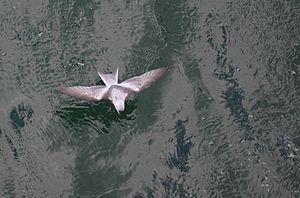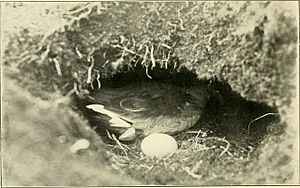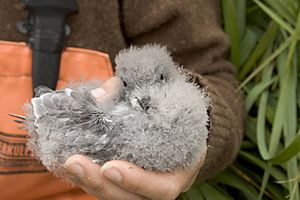Fork-tailed storm petrel facts for kids
Quick facts for kids Fork-tailed storm petrel |
|
|---|---|
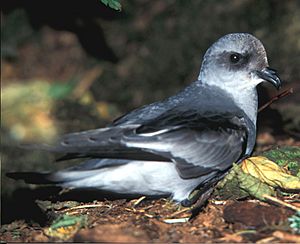 |
|
| Conservation status | |
| Scientific classification | |
| Genus: |
Oceanodroma
|
| Species: |
furcata
|
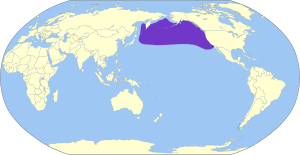 |
|
The fork-tailed storm petrel (Oceanodroma furcata or Hydrobates furcatus) is a small seabird. It belongs to the storm petrel family, called Hydrobatidae. This bird is the second most common and widespread storm petrel. It is also the only one in its family that is bluish-grey.
Fork-tailed storm petrels live in the open ocean, far from land. They spend up to 8 months in the northern Pacific Ocean. They only come back to land to lay eggs and raise their young. They nest in large groups called colonies. Their nests are often in rock cracks or small burrows. Each nest usually has one egg. These birds breed along the coast of the northern Pacific Ocean. This area stretches from northern California to northeast Asia.
They mostly eat tiny ocean creatures like planktonic crustaceans. They also eat small fish and squid. Sometimes, they will eat leftover bits from dead animals. Like other storm petrels, they find food by flying close to the water. They pick up food right from the surface.
Contents
What it Looks Like
The fork-tailed storm petrel is a small seabird. It is about 20 cm (8 inches) long. Its wingspan is about 46 cm (18 inches). When it looks for food, it flies with quick, stiff wingbeats. It stays very close to the water's surface.
Even though it's called "fork-tailed," its forked tail is not always easy to see. The best way to tell this bird apart is its bluish-grey feathers. Its belly is usually lighter in color. This creates a contrast with the darker feathers under its wings. It also has a dark grey forehead and a black patch near its ear. Its bill is small and black. Other storm petrels are much darker. For example, the ashy storm petrel looks similar but is darker. However, fork-tailed storm petrels from southern areas can be a bit darker than those from the north.
Male and female fork-tailed storm petrels look very similar. They are also about the same size. Young birds look like adults. The only difference is that their tail notch is not as clear.
Family Tree
The fork-tailed storm petrel belongs to the group of birds called Procellariiformes. These birds are also known as "tubenoses." This is because they have tube-like nostrils on their bills. It is part of the Hydrobatidae family.
The genus name Oceanodroma comes from old Greek words. Okeanos dromos means "ocean runner." This name describes how storm petrels fly and "run" on the ocean surface while feeding. The species name furcata comes from Latin. It means "branched" or "forked." This refers to their special forked tail.
There are two types, or subspecies, of fork-tailed storm petrels:
- O. f. furcata: This is the northern group. They breed from northeast Asia to Alaska.
- O. f. plumbea: This is the southern group. They breed from southeast Alaska down to northern California.
The main differences between these two groups are small changes in size and feather color. The southern birds are a bit smaller and darker. Southern birds also start and end their breeding season earlier. Scientists have not yet done special genetic tests to compare these two groups.
Where it Lives
The fork-tailed storm petrel lives in a very large area. This area is estimated to be 22,400,000 square kilometers (8,650,000 square miles). There are over 6,000,000 of these birds worldwide. This makes it the second most common and widespread storm petrel. During the breeding season, these birds gather in large colonies. These colonies are on islands along the coast. This includes northern California, Oregon, Washington, British Columbia, Alaska, and northeast Asia. Many of them live in Alaska, especially in the Bering Sea near the Aleutian Islands. Their southernmost colony is on Little River Rock in Humboldt County. About 200 birds live there.
Their nesting spots can be different. They might nest on bare rocks or in forests. They usually build their nests under rock cracks or tree roots. They can also dig burrows in soft ground with low plants.
Since they spend most of their time in the open ocean, we don't know much about them outside of the breeding season. They are often seen off the coast of California. This means they are the most northern storm petrels during winter. Some sightings also show that they travel as far south as Hawaii to find food.
How it Behaves
Sounds and Calls
Fork-tailed storm petrels are usually quiet. They only make calls when they enter their breeding colony at night. Their most common call sounds like a raspy "ana-ana-ana." It has 3 to 5 notes. Both males and females make this sound. This call is especially loud during courtship. During this time, they also do special flying displays. Males often make a higher-pitched, single note call. They use this call to find females in noisy colonies. It also helps them stay connected with their mate.
Diet
Like other storm petrels, the fork-tailed storm petrel mainly eats crustaceans and fish. They find this food near the ocean surface. Their diet includes tiny creatures like amphipods, myctophids, and copepods. They also eat shallow-water fish like greenling and sablefish, as well as decapods and squid. These birds are very opportunistic. This means they will eat whatever food they can find. They are often seen scavenging on fatty tissue from dead marine mammals. They also follow fishing boats to eat scraps.
Fork-tailed storm petrels have a very good sense of smell. They use smell a lot to find food. They are often the first birds to arrive at a strong-smelling food source. When they find food, they grab it by fluttering over the water. Sometimes, they might dive a little, up to 0.6 meters (2 feet) deep.
Like other tubenoses, the fork-tailed storm petrel can make stomach oil. This oil comes from the food they digest. They store it in a part of their digestive system called the proventriculus. This oil helps them go a long time without food. It also lets them carry rich, nutritious food back to their chicks from far away.
Reproduction and Life Cycle
Fork-tailed storm petrels spend most of their lives at sea. They only come to land to breed. This usually happens from late March to early April. To avoid predation by gulls and other dangers, they only enter their colony at night. They leave before the sun rises.
The fork-tailed storm petrel builds its nest in rock cracks or small burrows. These nests are usually on isolated islands. Courtship involves special calls and flying displays. This can last for several weeks. Once a pair forms, they usually stay together for the whole breeding season. If they successfully raise young, they often use the same nest every year. The female lays one white egg directly on the burrow floor. Both parents take turns keeping the egg warm for about 50 days.
Once the egg hatches, the adult bird keeps the chick warm for the first five days. This is done using a special warm patch on their belly called a brood patch. After five days, the chick can keep itself warm. Then, the parents leave the chick alone. They only return to feed it every one to four nights. After about two months of slow growth, the young petrel will finally fledge. This means it leaves the burrow and flies off on its own.
Fork-tailed storm petrels live in places with harsh weather. They have special ways to make sure their breeding is successful. For example, their eggs can be left alone for up to 7 days and still hatch. Also, their chicks can grow faster or slower depending on how much food is available. This is different from many other birds that grow at a steady rate.
Interactions with Other Animals
The fork-tailed storm petrel is often the only prey for predators early in the breeding season. This is because they return to these remote islands before other seabirds. These birds are a big part of the diet for animals like river otters, gulls, and raptors. Also, new predators brought to these islands, like foxes, martens, and raccoons, can greatly harm breeding groups. To protect themselves, fork-tailed storm petrels can spit their stomach oil at a threat.
Fork-tailed storm petrels usually get along well with other seabirds. They can even share breeding areas with birds like tufted puffins. But sometimes, they can be aggressive. They have been known to steal food from Leach's storm petrels.
Humans and Conservation
The fork-tailed storm petrel is widespread and common. It is not currently in danger of extinction. However, humans do affect their lives in several ways.
Since these birds feed on things floating on the water and follow ships, they often swallow oil and plastic with their food. Surprisingly, the fork-tailed storm petrel is not greatly harmed by the toxicity of oil. This is because their natural diet contains things that are chemically similar to oil. Plastics also don't severely harm these birds. They can regurgitate (spit up) the plastic after they swallow it.
However, as a top marine predator, fork-tailed storm petrels can be affected by bioaccumulation. This means harmful substances build up in their bodies over time. High levels of lead have been found in their bones. Also, a chemical called DDT can make their eggshells dangerously thin.
The biggest dangers to fork-tailed storm petrels today are global climate change and introduced species. More severe storms make it harder and more dangerous for them to find food. This lowers the chances that adult birds will return to their colony. Also, mammals brought to their islands can harm storm petrels. raccoons and river otters hunt their nests. rabbits can cause soil erosion. This can damage the burrows where the birds nest.
See also
 In Spanish: Oceanodroma furcata para niños
In Spanish: Oceanodroma furcata para niños




